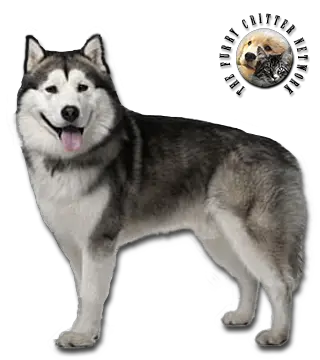Breed Standard
Head: Broad and strong. Broad skull. Slight stop. Strong, massive muzzle. Black or brown nose in red dogs. Close fitting lips.
Ears: Medium size, triangular, wide set. Held erect.
Eyes: Almond shape, set obliquely in the skull. Brown color. Blue eyes are a disqualifying fault.
Body: Compact and well muscled. Strong neck. Well developed chest.
Tail: Richly clad. Carried over the back, but not in a tight curl.
Hair: Thick, harsh; never long or soft. Hair is longer on the shoulders, neck, length of the back, croup, thighs and tail. Dense, wooly, oily undercoat is 2.5 to 5 cm long.
Coat: Light gray through intermediate shadings to black or shadings of sable to red. Color combinations are acceptable in undercoat. The only solid color allowed is white. White is always the predominant color on the underbody, feet, and parts of leg and face markings.
Size: Dog: 65 cm Bitch: 58 cm
Weight: Dog: 38 kg Bitch: 34 kg
History
For centuries, the Alaskan Malamute was indispensable to the native peoples of Alaska. He was named for the Mahlemuts, an Inuit tribe that developed this breed and used it for hunting caribou and guarding the camp. Though not as fast as the Husky, the Alaskan Malamute can pull heavier loads, earning it the reputation as the "snow train" of the north. The breed was recognized by the American Kennel Club in 1935. Breeding began in France in 1975, but the Alaskan Malamute is still rare in that country.
Behavior
This robust, calm, steady dog has great endurance. Though quite independent, he is not as feisty as the Husky. He is playful, affectionate, and gentle with children, making him an excellent pet. The Alaskan Malamute makes a poor guard dog because he rarely barks, is not aggressive, and is very sociable. His pack instinct is still strong, and he is rather dominant with other dogs. Firm training must begin at a very young age.
The Alaskan Malamute could possibly adapt to life in the city, but this dog does not like to be left alone and hates inactivity. If closed in, he will destroy a house. To maintain mental and physical health, this dog must take long, frequent walks, and if possible be allowed to pull loads. This breed does not tolerate heat well. Brushing twice per week is required. A curry comb is needed during seasonal shedding.
Malamutes, like other Northern and sled dog breeds, can have a high prey drive, due to their origins and breeding. This may mean that in some cases they will chase smaller animals, including other canines, as well as rabbits, squirrels, and cats. While Malamutes are, as a general rule, particularly amicable around people and can be taught to tolerate smaller pets, it is necessary to be mindful of them around smaller animals and small children.
Malamutes are very fond of people, a trait that makes them particularly sought-after family dogs, but unreliable watchdogs as they do not tend to bark. Malamutes are nimble around furniture and smaller items, making them ideal house dogs, provided they get plenty of time outdoors meeting their considerable exercise requirements. Alaskan Malamutes also often participate in animal therapy programs, like visiting patients in hospitals, due to their soft nature. If they are year-round outdoor dogs, letting them play in a baby pool filled with cold water in summer keeps them cool. In the winter, they prefer snow.
Malamutes are usually quiet dogs, seldom barking. When a Malamute does vocalize, it often appears to be "talking" by vocalizing a "woo woo" sound. A similar-looking Spitz dog, the Siberian Husky, is much more vocal.
Function
Sled dog (heavy loads over long distances), Pet.
Health
The most commonly reported health problems of Alaskan Malamutes in the 2004 UK Kennel Club survey (based on a sample size of 64 dogs) were musculoskeletal (hip dysplasia), and hereditary cataracts. There are additional health issues in the breed whose origins are unknown at this time including varied seizure disorders found in young puppies as well as adults, Epilepsy, congenital heart problems, kidney problems and skin disorders.
Other health issues in Malamutes include inherited polyneuropathy, chondrodysplasia, heart defects, and eye problems (particularly cataract and progressive retinal atrophy).






